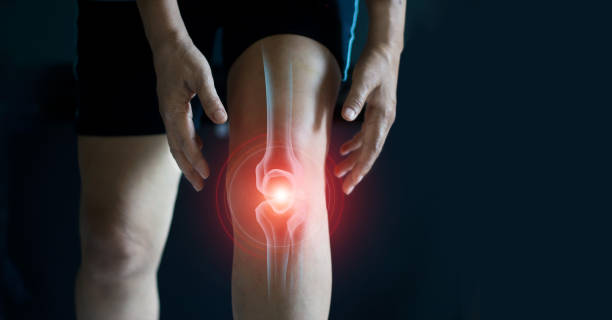Alternative Treatments, Joint Health
Discovering the Ultimate Solution for Osteoarthritis in Knees
Millions of people worldwide suffer from osteoarthritis, a degenerative joint condition that primarily affects the knees.
Finding the right treatment for osteoarthritis in the knees is critical for pain management, maintaining mobility, and increasing overall quality of life. In this article, we’ll take a look at the wide range of treatment choices available, from conservative approaches to surgical interventions. We look at the various techniques to ease symptoms and delay disease development, including lifestyle changes and exercise regimes, as well as drugs, injections, and new therapies.
By delving into the most recent research, expert views, and patient experiences, we hope to provide individuals with the knowledge they need to make informed decisions and find individualized solutions tailored to their requirements and situations.

Understanding Osteoarthritis in Knees
Osteoarthritis is a prevalent joint ailment that can impact every joint in the body, including the knees. It is a degenerative illness in which the cartilage in the joint wears away over time, resulting in discomfort, stiffness, and limited movement.
Symptoms and Diagnosis
The symptoms of osteoarthritis in the knees differ from person to person. Pain, stiffness, and reduced range of motion are some of the more typical symptoms. The discomfort may worsen after activity or extended periods of inactivity, and it may be accompanied by swelling or soreness around the joint.
A physical examination and a medical history are often used to diagnose osteoarthritis in the knees. They may also request X-rays or magnetic resonance imaging (MRI) to better examine the joint and determine the extent of the injury. Blood tests may also be performed to rule out other illnesses that cause similar symptoms.
Risk Factors and Prevention
A number of risk factors can enhance a person’s chances of acquiring knee osteoarthritis. Age is a significant risk factor, as the likelihood of developing the illness rises with age. Other risk factors include being overweight or obese, having a family history of the illness, and having experienced joint injuries or trauma.
While it is impossible to totally prevent osteoarthritis in the knees, there are activities that can be performed to lessen the risk of acquiring the condition. Maintaining a healthy weight, remaining active, and avoiding joint traumas or trauma can all assist in lowering the chance of developing osteoarthritis in the knee.
To summarize, osteoarthritis in the knees can cause substantial pain and limited mobility, but there are strategies to treat the condition and lower the risk of developing it. Individuals who understand the symptoms, risk factors, and prevention techniques can take action to protect their joint health and quality of life.

Non-Surgical Treatment Options
Osteoarthritis (OA) is a degenerative joint condition that affects millions of individuals globally. While joint replacement surgery is frequently the final resort in severe situations, there are some non-surgical therapeutic methods that can help relieve discomfort and restore joint function. In this section of the article, we will look at some of the most successful non-surgical treatments for knee osteoarthritis.
Lifestyle Modifications
People with knee OA may benefit from lifestyle changes such as weight loss and exercise. Being overweight or obese can increase pressure on the knee joint, exacerbating symptoms. Losing weight can lower the pressure and relieve pain. Exercise can also aid by increasing joint flexibility, strengthening muscles, and reducing stiffness. Low-impact workouts such as swimming, walking, and cycling are frequently recommended for persons with knee osteoarthritis.
Medications and Supplements
Several drugs and supplements can help with the pain and inflammation associated with knee osteoarthritis. Acetaminophen is a widely used pain medication that can be beneficial for mild to moderate discomfort. Nonsteroidal anti-inflammatory medicines (NSAIDs), such as ibuprofen and naproxen, can also help alleviate pain and inflammation. Glucosamine and chondroitin supplements have been demonstrated to improve joint function and alleviate discomfort in some persons with knee osteoarthritis. However, the evidence supporting their efficacy is conflicting.
Physical Therapy and Exercise
Physical therapy and exercise regimens can be modified to meet the specific needs of patients with knee osteoarthritis. They can assist increase joint flexibility, strength, and balance, resulting in less discomfort and better joint function. Tai chi and yoga are low-impact workouts that can be especially beneficial to persons who have knee osteoarthritis. They can improve balance and lower stress, which can aid with pain relief. Braces and other supportive devices can also help relieve discomfort and improve joint function.
Finally, there are various nonsurgical therapy options for knee osteoarthritis. Lifestyle changes, drugs and supplements, physical therapy, and exercise can all help manage pain and improve joint function. However, it is critical to contact a healthcare practitioner to establish which treatment alternatives are most appropriate for your specific circumstances.

Surgical Treatments and Advanced Therapies
Injections and Minimally Invasive Procedures
Non-surgical treatments, including injections and minimally invasive procedures, may be useful for patients with mild to moderate osteoarthritis knee discomfort. One of the most often utilized injections is hyaluronic acid, which lubricates and cushions the joint, reducing discomfort and stiffness. Corticosteroids are another option for reducing inflammation and pain.
Other minimally invasive procedures include osteotomy, which removes a small wedge of bone to redistribute the weight-bearing burden on the knee joint, and arthroscopy, which allows the surgeon to see and fix damaged cartilage or bone. These methods are less intrusive than joint replacement surgery and may benefit people with early-stage osteoarthritis.
Joint Replacement Surgery
Patients with severe arthritic knee discomfort who have not responded to previous therapies may require joint replacement surgery. Knee replacement surgery consists of removing the damaged joint and replacing it with an artificial joint comprised of metal and plastic.
While joint replacement surgery is a substantial operation, it can significantly enhance a patient’s quality of life by relieving pain and boosting mobility. Patients often receive physical therapy following surgery to help them regain strength and mobility.
It is crucial to highlight that joint replacement surgery does not cure osteoarthritis and may need to be repeated in the future. However, for many people, it can offer long-term relief from joint pain and stiffness.
In conclusion, while surgical treatments and sophisticated therapies may be required for people with severe osteoarthritis knee pain, non-surgical treatments such as injections and less invasive procedures may be useful for those experiencing mild to moderate pain. Patients should work together with their doctor to develop the optimal treatment plan for their specific requirements.
Managing Osteoarthritis in Daily Life
By making lifestyle changes and self-care for their knees, knee osteoarthritis patients can improve their quality of life.
Home Remedies for Self-Care
Home remedies and self-care routines can help relieve the symptoms of osteoarthritis in the knees. For example, icing or heating the affected area can help reduce swelling and inflammation. A knee brace or shoe inserts can enhance function and mobility. Furthermore, body weight management can assist in alleviating knee pain and enhance overall health.
Support Systems and Occupational Adjustments
Occupational therapy can assist people with knee osteoarthritis in making the required changes to their work environment to alleviate pain and improve function. Canes, devices, and alternative therapies can all aid with knee osteoarthritis symptoms.
Overall, managing knee osteoarthritis requires a multidimensional approach involving lifestyle changes, self-care practices, and support networks. Individuals who adopt these measures can improve their quality of life while also efficiently managing their symptoms.
Conclusion
To summarize, while there is no one-size-fits-all strategy for treating osteoarthritis in knees, a complex approach incorporating several strategies frequently produces the best outcomes. From lifestyle changes and physical therapy to drugs, injections, and surgical treatments, the best treatment strategy should be personalized to each individual’s unique needs, preferences, and severity of the problem. Patients can navigate their journey with better confidence and efficacy by staying up to date on the newest advances in osteoarthritis therapy and collaborating closely with healthcare experts.
Furthermore, adopting a proactive mindset, maintaining a healthy weight, and adding regular exercise into daily routines can help manage symptoms and improve overall joint health. Ultimately, with coordinated efforts and a comprehensive approach, individuals can try to maximize function, minimize discomfort, and improve their quality of life despite the limitations offered by osteoarthritis in the knee.
Trusted Health, Wellness, and Medical advice for your well-being



